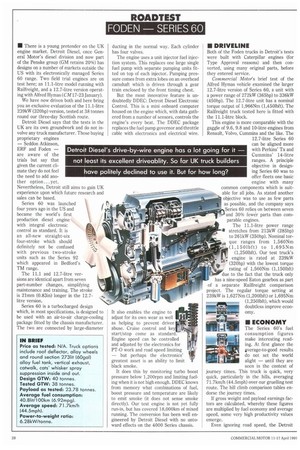ROADTEST
Page 30

If you've noticed an error in this article please click here to report it so we can fix it.
FODEN SERIES 60
• There is a young pretender on the UK engine market. Detroit Diesel, once General Motor's diesel division and now part of the Penske group (GM retains 20%) has designs on a number of markets outside the US with its electronically managed Series 60 range. Two field trial engines are on test here; an 111-litre model running with Railfreight, and a 12.7-litre version operating with Alfred Hymas (CM17-23January).
We have now driven both and here bring you an exclusive evaluation of the 11.1-litre 239kW (320hp) version, tested at 38 tonnes round our three-day Scottish route.
Detroit Diesel says that the tests in the UK are its own groundwork and do not involve any truck manufacturer. Those buying proprietary engines — Seddon Atkinson, ERF and Foden — are aware of the trials but say that given the current climate they do not feel the need to add another option .. yet. Nevertheless, Detroit still aims to gain UK experience upon which future research and sales can be based.
Series 60 was launched four years ago in the US and became the world's first production diesel engine with integral electronic control as standard. It is an all-new straight-six four-stroke which should definitely not be confused with previous two-stroke units such as the Series 92 which appeared in Bedford's TM range.
The 11.1 and 12.7-litre versions are identical apart from seven part-number changes, simplifying maintenance and training. The stroke is 21mm (0.83in) longer in the 12.7litre version.
Series 60 is a turbocharged design which, in most specifications, is designed to be used with an air-to-air charge-cooling package fitted by the chassis manufacturer. The two are connected by large-diameter ducting in the normal way. Each cylinder has four valves.
The engine uses a unit injector fuel injection system. This replaces one large single fuel pump with separate pumping units fitted on top of each injector. Pumping pressure comes from extra lobes on an overhead camshaft which is driven through a gear train enclosed by the front timing chest.
But the most innovative feature is undoubtedly DDEC: Detroit Diesel Electronic Control. This is a mini onboard computer housed on the engine which, with data gathered from a number of sensors, controls the engine's every beat. The DDEC package replaces the fuel pump governor and throttle cable with electronics and electrical wire.
It also enables the engine to adjust for its own wear as well as helping to prevent driver abuse. Cruise control and ke start/stop come as standard. Engine speed can be controlled and adjusted by the electronics for P1-0 work and road speed limiting — but perhaps the electronics' greatest asset is an ability to limit black smoke.
It does this by monitoring turbo boost pressure below 1,200rpm and limiting fueling when it is not high enough. DDEC knows from memory what combinations of fuel, boost pressure and temperature are likely to emit smoke (it does not sense smoke directly). Our test engine is not yet fully run-in, but has covered 18,000km of mixed running. The conversion has been well engineered by Detroit Diesel with no untoward effects on the 4000 Series chassis. Both of the Foden trucks in Detroit's tests were built with Caterpillar engines (for Type Approval reasons) and then converted, using many original parts, before they entered service.
Commercial Motas brief test of the Alfred Hymas vehicle examined the larger 12.7-litre version of Series 60, a unit with a power range of 272kW (365hp) to 336kW (4501ip). The 12.7-litre unit has a nominal torque output of 1,966Nni (1,4501bft). The Railfreight truck tested here is fitted with the 11.1-litre block.
This engine is more comparable with the gaggle of 9.6, 9.8 and 10-litre engines from Renault, Volvo, Cummins and the like, The 12.7-litre Series 60 can be aligned more with Perkins' Tx and Cummins' 14-litre ranges. A principle objective in designing Series 60 was to offer fleets one basic engine with many common components which is suitable for all jobs. As stated another objective was to use as few parts as possible, and the company says Series 60 relies on between seven and 30% fewer parts than comparable engines.
The 11.1-litre power range stretches from 213kW (285hp) to 261kW (350hp). Nominal torque ranges from 1,560Nm
r(1,150lbft) to 1,695Nm (1,250Ibft). Our test truck's engine is rated at 239kW (320hp) with the lowest torque
rating of 1,560Nm (1,1501bft) due to the fact that the truck only has a nine-speed Eaton gearbox as part of a separate Railfreight comparison project. The regular torque setting at 239kW is 1,627Nm (1,200Ibft) or 1,695Nm (1,2501bft), which would doubtless improve economy.
• ECONOMY
The Series 60's fuel consumption figures make interesting reading. At first glance the iverage-to-good results do not set the world alight — until they are seen in the context of journey times. This truck is quick, very quick, particularly in the hills, averaging 71.7km/h (44.5mph) over our gruelling test route. The hill climb comparison tables endorse the journey times.
If gross weight and payload earnings factors are calculated, whereby these figures are multiplied by fuel economy and average speed, some very high productivity values emerge.
Even ignoring road speed, the Detroit
















































































